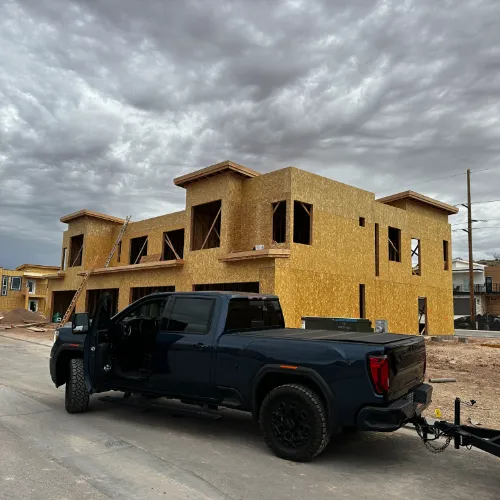If you’re building a new home, one of the most exciting milestones is when the framing goes up. It’s the stage where your future house transforms from a flat foundation into something three-dimensional. Walls take shape, rooms become visible, and the overall footprint of the home finally feels real.
Naturally, homeowners often ask the question: how long does framing a house take?
The answer depends on a number of factors ranging from the size of the house to the design’s complexity and even the weather. In this article, we’ll explore the typical timeline for framing, what can speed things up, what can slow things down, and what you should realistically expect during this important phase of construction.
What Is Framing in Home Construction?
Framing is the process of building the structural skeleton of the house. Using wood or steel, framers construct the walls, floors, and roof supports that form the backbone of the home.
During framing, you’ll see:
Wall studs going up, defining each room.
Floor joists installed, providing support for upper levels.
Roof trusses or rafters added to outline the roof.
Spaces cut out for windows and doors.
This stage is crucial because every other part of construction (drywall, roofing, plumbing, electrical, and finishes) depends on a strong, accurate frame.
The Typical Framing Timeline
On average, framing a standard single-family home takes between 1 to 3 weeks.
Here’s a breakdown:
- Small Homes (under 1,500 sq. ft.): 1–2 weeks.
- Mid-Sized Homes (1,500–3,000 sq. ft.): 2–3 weeks.
- Large Homes (3,000+ sq. ft. or custom designs): 3–6 weeks.
These are general estimates. Some homes go up faster, especially with experienced framing crews or prefabricated systems, while others take longer if the design is intricate.
Factors That Affect Framing Time
Several variables can influence how long framing takes. Here are the most common ones:
1. Size of the Home
This one is straightforward: larger homes require more materials, more labor, and more time. A simple ranch-style house will frame much faster than a sprawling two-story home with multiple wings.
2. Complexity of the Design
Open-concept floor plans, vaulted ceilings, custom features, or unique rooflines can add significant time to the framing process. The more intricate the architecture, the more precise and time-intensive the framing must be.
3. Type of Materials
Steel framing can take longer because it requires specialized tools and skills.
Wood framing is the most common and generally quick to assemble.
Panelized or modular framing (where sections are pre-built offsite) can speed things up dramatically.
4. Crew Size and Experience
A skilled crew of framers can work efficiently, completing the job faster while maintaining accuracy. Inexperienced or understaffed crews will take longer and may make mistakes that slow progress.
5. Weather Conditions
Rain, snow, or extreme heat can all delay framing. Wet conditions make it unsafe to work with power tools, and cold weather can slow down productivity.
6. Site Conditions
Uneven terrain, difficult access, or issues with the foundation can all cause delays before framing can begin or progress smoothly.
7. Supply Chain and Materials Availability
Delays in lumber delivery or shortages of framing materials can extend the timeline, even for straightforward projects.
The Framing Process Step by Step
To better understand the timeline, let’s look at what actually happens during framing:
- Sill Plates Installed – Lumber is anchored to the foundation, creating the base for walls.
- Floor Joists and Subflooring – Horizontal supports for the floors are laid out and secured.
- Wall Framing – Vertical studs and headers create walls and openings for windows/doors.
- Second Floor and Roof Systems – If applicable, framers install additional floors and roof trusses.
- Sheathing Added – Plywood or OSB panels are attached to exterior walls and roofs for strength and as a base for siding/roofing.
- Framing Inspection – Before moving forward, local building inspectors ensure the frame meets code and is structurally sound.
Each of these steps contributes to the overall timeline.
How to Keep Framing on Schedule
Homeowners and contractors can take steps to ensure framing stays on track:
- Hire Experienced Framers – Quality crews work faster and more accurately.
- Plan Ahead for Materials – Secure lumber, trusses, and sheathing before the project begins.
- Have Clear Blueprints – Detailed, accurate plans reduce confusion and errors.
- Communicate Regularly – Keep open communication between the builder, framer, and homeowner to avoid delays.
- Monitor Weather Forecasts – Plan for potential weather-related interruptions.
Common Delays During Framing
Even with the best planning, delays can happen. Here are some common issues that slow down framing:
- Incorrect or incomplete blueprints requiring revisions.
- Inspection delays if the local building authority is backlogged.
- Design changes requested by the homeowner after framing has started.
- Crew scheduling conflicts if multiple projects are happening at once.
Knowing these potential hurdles ahead of time helps set realistic expectations.
How Framing Fits Into the Overall Build Timeline
It’s important to remember that framing is just one phase of home construction. Here’s how it fits into the bigger picture:
- Foundation: 2–4 weeks.
- Framing: 1–3 weeks (sometimes longer for complex builds).
- Mechanical Rough-Ins (plumbing, electrical, HVAC): 1–2 months.
- Exterior Finishes (roofing, siding, windows): 1–2 months.
- Interior Finishes: 2–3 months.
So while framing itself can be fairly quick, it’s just the beginning of the construction journey.
To Wrap Things Up
Framing a house is one of the most exciting steps in the building process because it’s when your dream home begins to take shape. For most projects, you can expect framing to take 1-3 weeks, though larger or more complex builds may require additional time.
The key to staying on schedule is hiring an experienced framing crew, planning ahead with materials, and maintaining clear communication throughout the project.
With the right team in place, the framing process not only moves quickly but also lays the foundation for a home that’s strong, safe, and built to last.
